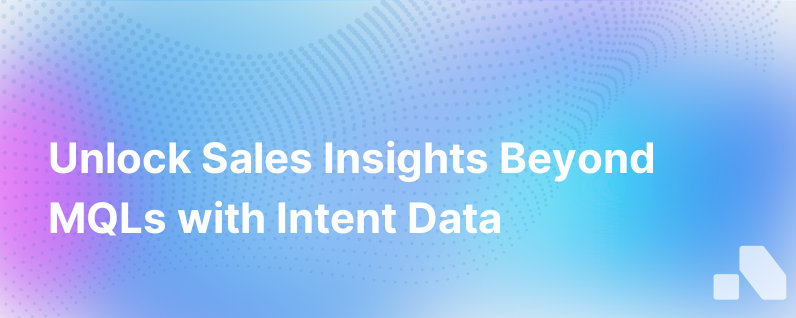
In the realm of sales and marketing, the traditional way of gauging potential customer interest has been heavily reliant on marketing qualified leads (MQLs). These are leads that have been deemed more likely to become a customer compared to other leads based on engagement metrics such as downloading an ebook, signing up for a webinar, or filling out a form. MQLs have been the lifeblood of marketing teams, shaping their strategies and directly influencing sales pipelines.
However, in the dynamic world of sales, there’s a beacon of deeper insight waiting to be levered – intent data. Intent data goes beyond traditional markers of interest, and dives into a lead's online behavior to give a clearer indication of their purchase intentions. It involves analyzing metrics like content consumption patterns, search engine queries, and website visits – to name a few. These insights can tell a story that MQLs simply can't.
Let's explore the intricate narrative intent data can tell your sales team and why it's fast becoming an indispensable asset in a marketer's toolkit.
The Downside of Relying Solely on MQLs
Marketing qualified leads can signal initial interest, but they reveal little about a lead's stage in the buying journey or the urgency of their need for a solution. MQL criteria often revolve around actions that merely show curiosity rather than a decisive buying signal, which can leave sales teams in the dark about the lead's actual intent.
Additionally, MQLs don't take into account whether a prospect is actively exploring other solutions or whether they fit into the ideal customer profile. Consequently, sales reps can end up chasing leads that are not sales-ready, not a good fit, or simply gathering information with no concrete buying intent.
Understanding Intent Data and Its Value
Intent data is the intelligence gathered about a person’s or company’s online behavior that indicates a higher level of interest or purchase intent related to a product or service.
There are two types of intent data:
- First-party intent data: Collected from your own web properties, like which blog posts a visitor reads on your site or what they download.
- Third-party intent data: Gathered from a network of publisher sites, offering a broader view of a lead’s behavior across various online platforms, not limited to your website.
Intent data tells you what topics your prospects are researching, which products they are comparing, and which issues they are trying to solve, providing a comprehensive view of buying intent.
What Intent Data Tells Your Sales Team
Here are several insights intent data provides that MQLs cannot:
-
Buyer Research Trends: Intent data tracks the topics and content themes that prospects engage with across the web, revealing their research interests and priorities. Knowing what a prospect is actively researching tells you what problems they're trying to solve, which helps sales teams position their product as the solution.
-
Competitive Engagement: This involves knowing if a prospect is looking at competitors and the extent of this engagement. Is the prospect just skimming the surface or deeply engaging with competitor content? This insight is crucial for timing your outreach and crafting your value proposition accordingly.
-
Buying Stage Identification: By analyzing the depth and nature of content engagement, you can ascertain a prospect's stage in the buying cycle – whether they are in initial research, actively seeking a solution, or nearly ready to make a purchase decision.
-
Account Prioritization: Intent data can reveal which accounts are 'in-market', helping sales teams prioritize efforts on leads that are showing active buying signals, increasing efficiency and potentially shortening sales cycles.
-
Content Personalization: Knowing a lead’s specific interests allows your team to personalize outreach more effectively. Tailored content that addresses a prospect's unique research or pain points can significantly improve engagement.
-
Signal-Based Selling: Sales reps can act on real-time signals rather than rely on historical data, enabling them to engage with leads in a more timely and relevant manner.
Integrating Intent Data Into Your Sales Process
To make the most out of intent data, here's how to integrate it seamlessly into your sales strategy:
-
Align Sales and Marketing: Ensure both teams understand the value of intent data and are aligned on when and how to act on the insights it provides.
-
Enhance Lead Scoring: Augment traditional lead scoring models with insights from intent data to better determine a lead's sales readiness.
-
Train Your Team: Ensure your sales team knows how to interpret and utilize intent data during their outreach and engagement efforts.
-
Refine Your Tech Stack: Utilize platforms that can aggregate and analyze both first and third-party intent data, providing actionable intelligence to your team.
-
Use Intent Data Responsibly: Be mindful of privacy concerns and ensure that you are using intent data ethically and within the guidelines of relevant data privacy laws.
Conclusion
Intent data presents an unprecedented ability to understand and anticipate customer needs, allowing sales teams to engage with prospects in a much more personalized and meaningful way. It takes the guesswork out of deciphering whether a lead has true buying intent, making your sales approach smarter, more targeted, and ultimately more effective.
Shifting the focus from MQLs to intent-driven engagement doesn't mean dismissing the former entirely. Instead, by combining MQLs with the rich narrative intent data provides, your sales and marketing teams can gain a holistic picture of your prospective customers.
Aomni understands the power of intent data. By bridging the gap between sales and marketing with cutting-edge AI, we help you surface intent-driven insights to supercharge your sales strategy and operationalize your data for maximum impact.